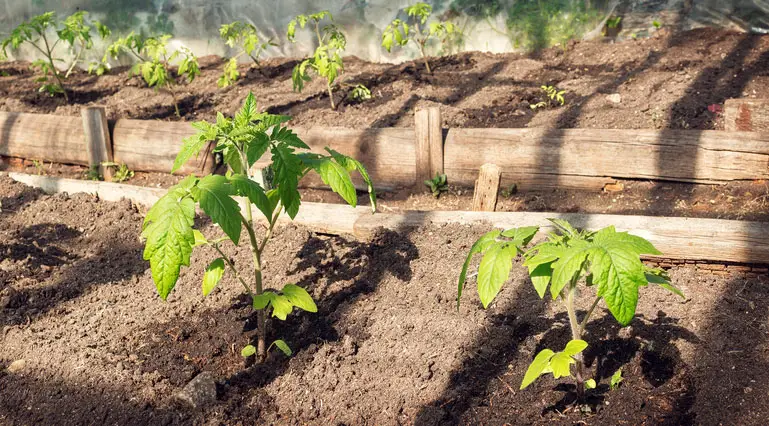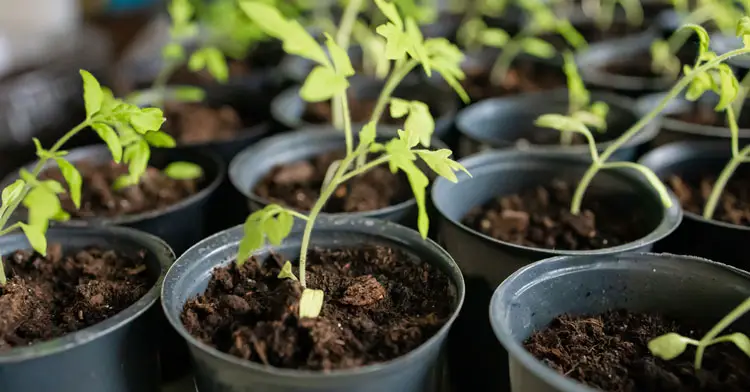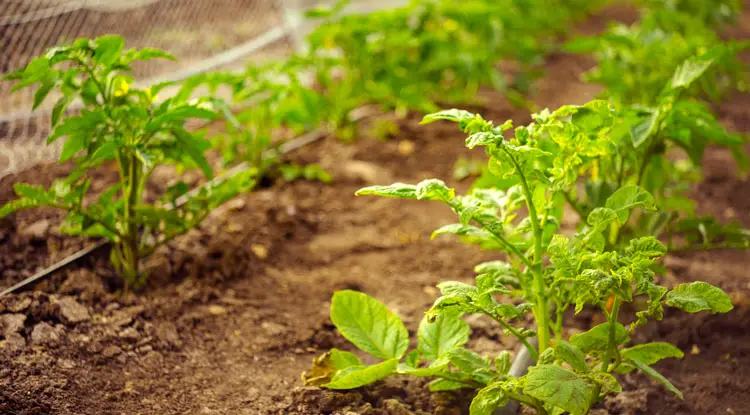Top Reasons Why Your Tomato Plant Isn’t Growing (At Every Stage)

This post follows our research editorial guidelines.

Tomatoes are one of the most hardy vegetables you can grow and at the same time challenging when you see no progress in the overall growth.
There are many factors that you need to consider in order to figure out why this is happening; the most common reasons include high temperatures, lack of nutrients in the soil, overwatering, and some growth ratio differences between the tomato varieties. In this article, we will explore together why your tomatoes aren’t showing any progress, and what you can do to fix it.

Table of Contents
What prevents a tomato plant from growing?
In most cases, the tomato plant is lacking attention in one of 3 areas. These include regular watering, fertilizing, and pruning. If you haven’t seen any physical changes, then you will need to tune up your maintenance.
Why are your tomatoes growing slow?
Possible causes of slow growth include:
- Soil is Lacking Nutrients – this can happen when the soil hasn’t been changed or enriched in quite some time.
- Irregular watering/ Overwatering – either too much water or too little water is going to cause issues.
- Extremely High/ Low Temperature – same with water, if it is extremely hot or cold the growth ratio gets stuck.
- The Tomato Variety Has a Slower Growing Ratio – not all varieties are the same; some tomatoes have a different maturity level than the other classic ones.

Slow growing seedlings
Temperature is too hot or too cold
The best season for growing tomatoes is late spring towards midsummer. Tomatoes need about 70 degrees to develop and enter the flowering cycle. Once the cycle begins, they tend to become established- it is common to notice some slowing in the growth during this stage. If the temperature rises above 100 degrees (too warm) or it drops below 40 degrees (too cold) they will become stagnant.
Irregular watering
The addition of water helps with sprouting, and it needs to follow a specific schedule so the plant can reach its full height. The trick here is that they are in need of water so they can become established, but they don’t enjoy spending every day sitting in it.
Not enough sun
The ideal amount of sunlight tomatoes need is between 5-8 hours. Whether you place the tomatoes indoors or outdoors isn’t a problem, as long as you make sure they have the right spot to grow. A sunny window with direct light is perfect if you choose to have them indoors. If you place them outdoors, the same amount of sunlight applies. Anything less than 5 hours of sun, will cause wilting, brown leaves, and no visible signs of growth.

Tomatoes in the vegetative stage
They might be rootbound
This is the most likely cause, especially if you have chosen soil that is loamy or sandy. The soil can block the whole flow and absorption of nutrients. You can fix this by adding compost (or organic matter to the current soil mix), so you can improve the overall soil texture. You might have to repot the plants into a bigger pot in some cases, and it is best to massage the roots before you transfer them into the new location; untangling the rootbound roots can offer great relief.
Inadequate drainage and narrow soil depth
You might be offering at least 1000 ml of water, but if there is no room for drainage, and the space for the tomatoes seems a bit tight, it will set off the vegetation. As a first symptom, you will notice that the leaves are going to start to wilt and turn inwards. Tomato plants are known to grow roots on their stems, usually close to the first set of leaves. Planting them in a space where the soil can be close to their first set of leaves is usually recommended. By doing this, the plant will be able to grow larger roots and it will enter the vegetative stage.
Too much fertilizer
Even if you have the best intentions, you may fall into the trap of offering too much fertilizer. The problem with this is that the tomatoes have a tendency to get leggy and grow longer stems (that end up being weak) as a reaction when they are bombarded with nutrients. If you’re fertilizing every week, take a step back, and flush the soil with some water a few times. Wait until it is completely flushed out and then let the tomatoes be. The usual fertilization ratio is every 20-25 days (depending on the instructions on the bottle).

Tomato plants not growing fruit
Inadequate pollination
Since tomatoes are self-fertile, making them accessible to pollinating insects is the easiest way to grow tomato fruits easily. The bees are shaking the flowers with the goal to let the pollen loose. Once they contact the flowers, they are able to shake the pollen and transfer it to the female flower part that is able to catch it. If you have the tomatoes indoors, make sure you open the windows so the bees can have access to them. If the bees don’t visit as much, you can shake the plants softly, so you can imitate the bee’s work.
Extreme heat
This can completely affect the growth of fruit since tomatoes can not handle high temperatures above 30 degrees. If during the night the temperature falls below 24 degrees, it has the ability to make the pollen sterile. In such cases, a shade cloth above the tomatoes can become quite handy, since it can keep them protected. Follow the same watering regimen, so they don’t feel thirsty- humidity will be kept high as well. In terms of cold temperatures, the tomato plant can be quite hardy. It is common practice to let the plant grow from the seed in between hot and cold temperatures- it acts as a way to strengthen the plant.
Why are my tomatoes not ripening?
You might have to cut off the new growth
If you happen to live in warmer climate zones, after the growing season (early October), you can prune the plant. You can also do this in colder climate zones, just make sure to do it gradually, offering the plant enough time to adjust in between the prunings. This will release it from any new growth you see there, and it will recharge the plant overall. It will additionally give the signal not to waste any extra energy on producing new leaves; the tomatoes will then be able to ripen faster.
Have you trimmed the flowers?
After the awaited pollination, the usual amount of time needed for the tomatoes to ripen out is 2-3 months. If it’s been longer than 3 months, it might be time to trim the flowers and let the plant be. You can start fresh next spring.
Pinch the suckers
Suckers are small leaves that shoot from where the stem and the branch intersect. This is probably the number one reason once the tomatoes reach their adult stage. If they remain unripped, you might need to locate the mini stems that are in between the branches and the leaf joint. Suckers absorb all the needed energy- the tomatoes won’t turn red until you pinch them.
Get rid of all the small tomatoes
You may think that they will ripen out, but the chances of this ever happening are extremely low. The tiny tomatoes won’t have enough time to turn red before fall sets in, so it is best to prune them off and let the plant concentrate on the existing big tomatoes it has on it. Next year it will focus on doing better. This applies to both warm and cold climates. Just remember that in cold climates you have to get rid of them gradually and not all at once.
Prune the stems
Over time, you will notice that the stems will grow and gain their length. If you just let them be, they will start becoming “leggy” and the leaves will start to wilt. This isn’t a sign of a disease, just a pure sign that it is time to prune the plant. Regular pruning is needed for climbing plants like tomatoes since they then focus to shoot newer stems that are healthier than the last ones. Pruning the leggy stems will certainly give the plant the signal to focus on ripening the existing tomatoes; think of it as removing the unnecessary workload that the plant doesn’t have to perform, so it can focus on the important task.
Final Thoughts
Tomatoes can sometimes be challenging when they are growing slowly, but the good news is that with the right monitoring and maintenance you can encourage it and enjoy some beautiful tomatoes from your own garden!
Offering a satisfying amount of fertilizer can help any stagnant tomato plants- they are in need of the right set of nutrients in their roots and soil to produce healthy crops. Be careful of the temperature and never allow the tomatoes to be exposed to either too much heat or cold since they tend to get confused and prefer to pause their growth till the right conditions are met. Lastly, a balanced and thorough watering can do wonders, as tomatoes prefer modest watering since they are susceptible to root rot. If you notice that the tomatoes aren’t growing sufficiently, refer back to the tips above for better guidance.
Happy harvesting!
